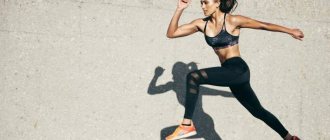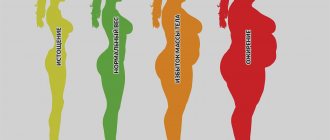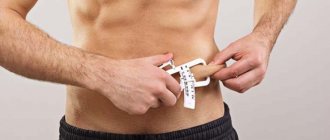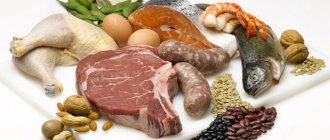How to find out your fat percentage?
There is no exact way to say this with 100% success. There are more accurate methods, there are simple methods that show this approximately.
Identification from photographs
The fastest and easiest way. To determine your body fat percentage, you need to find a body shape that is as similar to yours as possible.
Pros: fast, free.
Cons: requires your assessment of yourself, which is not always objective. We may unconsciously “throw off” a few pounds in our minds and compare ourselves to the slimmer version in the photo.
Using a caliper
A caliper is a special device that measures the thickness of the skin-fat folds in different parts of the body. Based on the obtained figures, the percentage of fat is determined using special tables or formulas.
Method number 1: measurements for women

1. Back of the shoulder: the fold is taken vertically in the middle between the shoulder joint and the elbow.
2. On the side: the fold is taken from the side diagonally in the middle between the lower rib and the hip bones.
3. On the stomach: the fold is taken vertically at a distance of +-2.5 cm away from the navel.
We calculate the percentage of fat using the formula:
% fat = (A-B+C) + 4.03653 , where:
A = 0.41563 x (sum of all three folds in mm)
B = 0.00112 x (sum of all three folds in mm squared)
C = 0.03661 x age in years
Method No. 2: measurement for women and men

We add the resulting numbers in mm and find out the percentage of subcutaneous fat using the table:
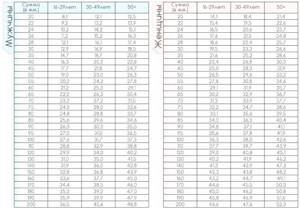
Cost: 500-800 rubles per caliper.
Pros: fast, you can do it yourself at home, fairly accurate indicators.
Cons: you need practice to learn how to use it correctly or someone else's help, calculations using formulas are required.
Bioimpedance analysis
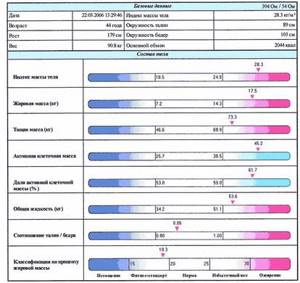
A weak current is passed through the body using electrodes attached to the ankles and wrists, after which the electrical resistance of the tissue is measured. The method is based on the fact that fat mass and the rest of the “dry” body mass have different resistance.
Cost: 1000-3000 rubles in private clinics or free under the compulsory medical insurance policy in public health centers.
Pros: fast, does not require any activity.
Cons: price, need to visit a clinic, use of equipment of varying quality. Not always accurate indicators, since the figure may be affected by water balance (edema).
Scales with fat percentage analyzer
The principle is the same as in bioimpedance: the device passes a weak current through you and calculates tissue resistance.
Cost: 2500 - 10000 rubles
Pros: fast, suitable for regular home use.
Disadvantages: the same as for bioimpedance - price, not always accurate indicators, since the figure can be affected by water balance (edema). When repeated measurements, fluid loss may show on the scale a decrease in the percentage of fat mass, although in fact it has remained unchanged.
Underwater weighing method

The method is based on Archimedes' law: a solid body immersed in water loses as much weight as the liquid it displaces. Since dry body mass and fat mass are different in density, the percentage of fat mass is determined by comparing body density after regular weighing and underwater weighing. The method is complex and rarely used.
Cost: Unable to find out
Pros: the most accurate method to date.
Cons: Duration 45-60 minutes, difficult procedure and likely high cost. Fear of underwater diving.
Determination by body mass index from Lyle MacDonald
The method is only suitable for untrained people, i.e. for beginners who have not yet started strength training. For the lucky owners of visible muscles built in the gym beyond the “norm”, this method is not suitable.
To determine your body fat percentage, you need to know your body mass index.
BMI = weight in kg/height in square meters
For example: 50/(1.64*1.64)=18.5. Next, use the table in the picture and find your match:

Table 1 The ratio of skeletal mass, muscle, fat.
| Men | Women | |||||
| 25 years | 40 years | 55 years | 25 years | 40 years | 55 years | |
| skeleton | 15% | n.d.* | n.d. | 12% | n.d. | n.d. |
| muscles | 45% | n.d. | n.d. | 35% | n.d. | n.d. |
| fat | 15% | 22% | 25% | 27% | 32% | 38% |
| skin, connective tissue, tendons, blood plasma, organs, hair, glands, etc. | 25% | n.d. | n.d. | 26% | n.d. | n.d. |
* - n.d. - no data
The average person is approximately 70% water. For example, muscles contain 70% water, 20% proteins and 5% various minerals and organic substances. Even fat and bones contain up to 50% water.
The skeleton of an ordinary person is very light. A woman weighing 64 kg has bones weighing about 7.75 kg, while a man weighing 77 kg has only 11.5 kg of bones. So the usual excuse for being overweight with “big bones” is nothing more than an excuse.
What is the difference between excess weight and excess fat? How to distinguish them?
In the body of an obese person, the proportion of fat increases, while the proportions of muscles and bones change slightly. Weight gain due to bone growth is unlikely, because even a 10% increase in bone mass will lead to an increase in body weight of only 1-1.5 kg. Muscle is heavier than fat and bone, so by increasing muscle mass with exercise and good nutrition, you can achieve dramatic weight gain. Thus, an athlete with a lot of muscle mass (such as a weightlifter) will weigh much above average. According to a classification based on body mass index, he would be overweight, although he would have no more than average body fat. In this case, it is better to estimate fat content by waist circumference or measure it using hardware methods. If your fat content is low, then you don't need to lose weight. However, it is extremely unlikely that you would accidentally gain weight through muscle mass. What do you see in the mirror: tight, defined muscles or flabby muscles? Sometimes weight gain is caused by fluid retention in the body. Some conditions (such as premenstrual syndrome in women) and diseases (such as heart disease) cause more fluid to remain in the body than usual. In this case, the face, stomach, and ankles often swell. If these signs occur, be sure to consult a doctor. However, for 99% of us, excess weight means excess fat.
In addition to the relative amount of adipose tissue, an important indicator is also its distribution across different parts of the body - primarily the ratio of waist to hip volume. In women, the normal ratio of waist to hip circumference should not exceed 0.7. For men, this value should not be higher than one. The relative volume of the waist and hips characterizes a person’s body type - “pear” (female type of fat tissue distribution) and “apple” (male type). In the first case, fat is concentrated mainly in the lower abdomen and buttocks. In the second case, fat is concentrated in the upper half of the body - the stomach hangs over the belt. The “apple” type more often leads to the development of complications in the form of obesity, atherosclerosis, coronary heart disease, diabetes and other diseases associated with excess body weight. Therefore, the body weight of people with this type of figure should be at the lower limit of the norm, and for people with a pear-shaped type of figure it can reach the upper limit. People prone to obesity need to closely monitor their weight and waist and hip size in order to promptly change the calorie content of food, its volume and quality.
10 Second Test - Waist Circumference
Waist circumference is a reliable indicator of whether your weight poses a health risk. Measure your waist circumference without stretching or loosening the measuring tape too much. Waist circumference is measured at the narrowest part of the torso or approximately 2.5 cm above the navel. Record the measurement and evaluate using the key:
Men A waist circumference greater than 94 cm indicates some health risk. With a waist circumference greater than 102 cm, the health risk increases significantly.
Women A waist circumference greater than 80 cm indicates some health risk. With a waist circumference greater than 88 cm, the health risk increases significantly.
NOTE: Abdominal obesity can also be identified using waist/height and waist/hip ratios. However, they are more difficult to use and research shows they are no more accurate than the waist circumference test shown here.
Let's imagine two people with the same weight and height. One of them plays sports and has a large muscle mass, the other leads an inactive lifestyle and has a small muscle mass and a lot of fatty tissue. They will look different: the first one will be fit and slender, and the second one will be loose and flabby, but when calculated, their body mass index will be the same. Therefore, body mass index as an indicator of ideal weight is used only for people with average muscle and fat tissue development. It is not body weight itself that affects health, but the proportion of fat tissue in it. Its content in the body can be determined by the thickness of the skin-fat fold. It is measured using a special compass - a caliper, which compresses the tissue with a strictly defined force. Measurements are taken at four points: above the triceps brachii muscle, above the biceps brachii muscle, at the angle of the scapula and above the iliac crest (at the navel) - and the average value of the obtained values is calculated. The content of adipose tissue in the body of adults can be determined from the table. 2.
To do this, measure the folds: 1 fold above the biceps (front surface of the shoulder) 2 fold above the triceps (back surface of the shoulder) 3 fold under the lower angle of the shoulder blade (on the back) 4 fold 2-3 cm away from the navel (on the stomach)
Add up the fold size in mm. and divide by 4, you get the average thickness of the skin-fat fold.
Table 2 Determination of the proportion of adipose tissue based on the average thickness of the skin-fat fold (SFA)
| KZhS, mm | Proportion of adipose tissue, % of total body weight | |
| husband. | female | |
| 4-5 | 6 | 7 |
| 6-7 | 11 | 13 |
| 8-9 | 13 | 16 |
| 10-11 | 16 | 20 |
| 12-13 | 19 | 23 |
| 14-15 | 21 | 24 |
| 16-17 | 22 | 27 |
| 18-19 | 23 | 28 |
| 20-21 | 24 | 30 |
| 22-23 | 25 | 30 |
| 24-25 | 26 | 32 |
| 26-27 | 27 | 32 |
| 28-29 | 28 | 34 |
| 30-31 | 29 | 35 |
| 32-33 | 30 | 36 |
| 34-35 | 30 | 37 |
| 36-37 | 31 | 37 |
| 38-39 | 31 | 38 |
| 40-41 | 32 | 39 |
| 42-43 | 33 | 39 |
| 44-45 | 33 | 40 |
| 46-47 | 34 | 41 |
| 48-49 | 34 | 42 |
| 50 | 35 | 42 |
the norm is 25 years for men 15%, women 27%, the norm is 40 years for men 22%, women 32%, the norm is 55 years for men 25%, women 38%.
There are special devices that use the electrical resistance of body tissue to determine the relative fat content in it. Now you can buy household electronic floor scales, which during weighing determine the proportion of fatty tissue in the body. Also, usually a fat analyzer is built into exercise bikes and, finally, you can purchase a separate device that is designed only to determine the amount of fat. This method is very good for targeted weight loss, as it allows you to monitor the decrease in fat mass and prevent the loss of muscle tissue.
The middle skin fold method is quite accurate. You can determine the % fat using a fat analyzer on a home exercise bike and get the value ...%, then use a regular ruler to measure 4 folds (of course, measurements with a ruler are a little inaccurate) and from the table we get ..% fat.
Very often, in the process of losing weight, a situation arises when we seem to continue to follow a diet, but the weight does not decrease. There are many reasons for this. For example, we are bad at dieting; or a woman is in a certain phase of her cycle, and fluid is retained in the body; or everything is fine, but after the herring eaten for dinner the day before, one and a half to two liters of water have accumulated in the body. It’s useful to know that every extra gram of table salt retains one hundred milliliters of excess water in the body. Having determined body composition, we can say: “Look, your fat mass continues to decrease, and the fact that you weigh no less than last time is simply the result of water retention. This is a fairly common situation among obese people.” Or another example: weight is reduced, but it is very important to determine which component of your body - fat or protein tissue is lost to a greater extent. Losing protein is bad: your muscles will become flabby, your skin will become wrinkled, your immunity will decrease, and heart problems may arise. And it's good when we lose excess fat. This is where body composition control would also help.
Why calculate your body fat amount?
Every time you step on the scale, you notice a certain dynamic. You either gain weight or lose weight, albeit slightly. But the pounds you lose are not always fat. This could be muscle mass or simple dehydration. If you want to lose weight or gain weight, you should be interested in subcutaneous fat. Additionally, the formula is more accurate if you know how much excess deposits you have in your body. Therefore, it is imperative to find out this indicator, and today we will talk about how to do this.
The simplest ways to determine the amount of body fat
Weight based on height and age is determined taking into account the amount of body fat. It may be large, but it will consist only of muscles, water and bones. Let's look at how to determine your body fat percentage:
- Special scales that determine the amount of fat in the body. Only you can decide whether to trust this invention of mankind, since it is impossible to accurately verify whether the information you receive is true.
- You can carefully examine yourself in the mirror and determine the amount of excess fat. But it is difficult to evaluate yourself objectively, so this method is rarely accurate.
- Use to measure your waist and forearm. If there are fewer centimeters on your waist and more on your arms, then your body fat decreases and your muscle mass increases.
Any of these methods is available to every person, but with their help you cannot know the exact results. In addition, by assessing the general condition of the fat layer, you will not get specific numbers.

To find out your body fat percentage using the Lyle MacDonald method, you must calculate your BMI. To do this, use the formula: BMI = weight in kilograms/height in meters squared. Next, find your indicator:
- BMI = 13-20. Then the percentage of fat is 13.5-24;
- BMI = 21-30. The percentage of fat is 25.5-39;
- BMI = 31-40. The percentage of fat is 40.5-54.
This method of determining the thickness of the fat layer is quite popular among girls, but there are other methods that allow you to calculate this indicator more accurately.
Norm BZHU
It is necessary to focus not only on calorie content, but also on the BJU norm. To gain muscle mass, the ratio of proteins, carbohydrates and fats may be even more important than calorie intake.
To calculate your BZHU norm, you still have to calculate the required calorie content. It will be needed to display the intake rates for fats, proteins and carbohydrates.
Calorie content of BJU:
- 4.5 kcal per 1 gram of protein;
- 4.5 kcal per 1 gram of carbohydrates;
- 9 kcal per 1 gram of fat.
To gain muscle mass, you need to adhere to the following ratio: 45% protein, 25% fat, 30% carbohydrates.
Let's calculate the norm of BZHU for Anna, already familiar to us, who decided to lose weight. She works out in the gym 3 times a week, which means her daily caloric intake is:
1,578.7 x 1.55 - 20% = 1,958 calories.
This works out to: 881.1 calories from protein, 489.5 from fat and 587.4 from carbohydrates. The obtained values must be converted into grams, for which we divide them by the calorie content of the BJU presented above. This yields approximately 196 grams of protein, 54 grams of fat and 131 grams of carbohydrates.
The BZHU for weight gain is calculated similarly. The ratio is 35-40% protein, 15-20% fat and 40-50% carbohydrates.
How is the BZHU norm calculated for weight maintenance? To do this, you need to consume approximately 1 gram of protein and 1.1 grams of fat and 4 grams of carbohydrates per 1 kilogram of weight. The BJU norm in this case is individual, so at first you will have to adjust your diet.
If you want to calculate the norm of BJU for maintaining weight according to the previous scheme, then the ratio is as follows: 25% protein, 30% fat and 45% carbohydrates.
Never exclude fats from your menu! This can be detrimental to your health!
The most effective way to determine the amount of fat in the body
If you are interested in how to determine your body fat percentage using medical equipment, then you should evaluate your financial capabilities. Even in government agencies, this method requires money, but it is the most accurate of all possible. It is used by professional athletes before competitions when it is necessary to provide official data on the condition of the body.
The essence of the method is this: special electrodes are attached to the wrists and ankles, through which a weak electric current passes. The body's tissues resist it, and the level of this resistance is measured by medical devices. You will know the result immediately after the procedure.
But this method has a significant drawback. If your body is not properly hydrated, the equipment may give incorrect results. Therefore, the procedure is usually performed twice. When swelling in the body disappears, the devices may show a lower fat percentage than the previous time.
There is no need to carry out such an analysis without the need or a special referral from a doctor; it is better to use other methods to calculate the amount of body fat.

Underwater weighing method
Ideal weight based on height and age can only be determined by taking into account the amount of fat in the body. The underwater weighing method gives the most accurate result of all methods known today.
The essence of the underwater measurement is this: when a person is completely immersed in water, he loses the amount of weight that was displaced from the container in which he is located. After the procedure, the person is weighed on ordinary medical scales, and specialists compare the weight in the water with the body weight on land. After certain calculations are carried out, the amount of fat in the body is calculated.

Using a caliper for women
To find out your body fat percentage (the norm for women must be strictly observed, since this greatly affects overall health indicators), use a caliper. This is a device that is used to measure the thickness of the fat layer in any area of the body.
So, how to determine your body fat percentage using a caliper:
- Find out the thickness of one fold of fat on the back of the shoulder;
- Calculate the thickness of the side fold between the ribs and the thigh bone;
- Measure the thickness slightly away from the navel;
- Use the formula: (the sum of all three folds in centimeters + the same figure squared + 0.03661 * the number of your years) + 4.03653.
You need to practice to calculate your body fat percentage yourself. The norm for women is that exact results are calculated 3 times. Using this device you can calculate the amount of fat in men.

How many calories should you consume?
You can try to look for the exact amount of calories you need to consume daily in different sources, or you can calculate it yourself using a proven formula:
655 + 9.6 × (weight in kg) + 1.8 × (height in cm) – 4.7 × (age in years).
For example, for Anna at the age of 45 with a height of 172 cm and a weight of 86 kg, the formula will take the following form:
655 + 9.6 x 86 + 1.8 x 172 – 4.7 x 45 = 1,578.7 calories per day.
The result does not take into account physical activity. That is, we received the amount of calories needed during normal life.
If you do additional physical education, then you need to multiply the result by:
- 1.38 with one active session per week or morning exercises daily;
- 1.55 if a person is actively engaged three to five times a week;
- 1.73 if classes are held daily.
The resulting number can be considered the basis for further calculations.
For example, if you want to lose weight, then the calorie intake should be reduced by 20%.

For the growth and development of the muscle frame, you need to know the calorie intake for gaining muscle mass. Good news for food lovers: you can eat less restrictively if you want to build muscles! You will need to consume more calories to gain and increase the percentage of muscle mass in your body. The calorie intake in this case is 15% higher than the basic one.
This is a must. Muscles need energy to grow, but where will you get it if you cut your own calories?
Using a caliper for women and men
The fat calculator below is quite accurate, but you need to practice using the device to get reliable results. So, to find out your indicator, follow the instructions:
- Find out the thickness of the fold on the back of the shoulder.
- Measure the thickness of the fat fold on the front of the shoulder.
- Calculate the thickness of the fold on the stomach.
- Add up all the obtained indicators.
To find out the amount of fat in the male body, use the following data:
About the fat content in a woman's body
Fat is present in the body of all healthy people and this is normal. First of all, it serves as a source of energy. Secondly, it is a kind of “protector” of internal organs, protecting them from injury and hypothermia. It actively participates in all metabolic processes and affects male and female reproductive function.
But how much fat should be in a woman’s body so that she can boast of a beautiful body and good health remains a mystery to most people who are losing weight.
When calculating the percentage of fat mass in the body, individual indicators should be taken into account. These are age, weight, height and physical activity.

Body fat percentage is calculated individually
Unlike men, women are naturally more prone to storing fat to nourish the fetus during pregnancy and lactation. The percentage of fat in young and mature women cannot be the same by definition. After all, hormonal levels and the ability to have children depend on this amount.
Thus, its deficiency leads to menstrual irregularities and improper functioning of the ovaries. Athletes working on creating a fitness figure strive for minimally low indicators. Together with specialists, they determine the calorie content of the diet and the activity of physical activity.
Important! The storage of fat cells in the body occurs not only when there is an excess of calories, but also during fasting. Receiving insufficient calories to maintain optimal body function, the body stores and stores them in case of a prolonged fast for energy.
Top products for fat burning

The main experts consider the following.
- Vegetables and greens. Thanks to fiber, they are perfectly satiating without adding extra calories.
- Egg white. An indispensable product in the difficult task of losing weight.
- Lenten bird. It can be turkey or chicken, and you need to choose the breast. Unfortunately, the rest of the meat contains too much fat, so you will have to give it up or seriously reduce its consumption to a couple of times a month.
- Citrus. Make special mention of grapefruit. Several very effective diets have been built on the constant use of this fruit.
- Celery. Its calorie content is so low that when consumed, the body expends more energy to digest it than it receives from it. Energy deficiency causes weight loss.
The norm of fat, water and muscle mass in the body of women
There is no specific indicator of fat mass content, since no two organisms are alike.
What percentage of body fat is normal for women and girls? The answer to this question depends greatly on age:
- up to thirty years of age, a level of 16-20% fat is considered normal;
- ladies from 30 to 50 - 18-23%;
- for older women 20-25%.
There should be at least 55-60% water in the body of a healthy person.
Important! At the medical center you can calculate and find out your own ratio of water, muscle and fat. For this, a special device is used - a caliper or a computed tomography method.
Normal for women
The norm of muscle mass is individual for each person. Due to the existence of different body types, it is not a specific norm that is distinguished, but a range of total body weight. The calculation also takes into account age.
During the aging process, scientists have observed a tendency for muscle mass to decrease, and this is normal. This is due to a slowdown in metabolic processes in the body, accumulation of subcutaneous fat, and acquired diseases.
Muscle mass (normal for women), depending on age, is presented in the table:
| Age | Deficiency (disadvantage), when less... | Norm | Surplus (excess), when more... |
| Newborn | 18% | 23-25% | 29% |
| Child 5-8 years old | 22% | 27-31% | 35% |
| Teenager 10-16 years old | 25% | 30-33% | 34% |
| Youth 17-20 years old | 34% | 35-37% | 38% |
| 20-29 | 33% | 34-36% | 36% |
| 30-39 | 31% | 33-38% | 39% |
| 40-49 | 30% | 31-36% | 37% |
| 50-59 | 29% | 29-34% | 35% |
| 60-69 | 28% | 28-33% | 34% |
| 70-100 | 27% | 27-32% | 33% |
How to correctly calculate the percentage of fat in a woman’s body
So, the goal becomes clear - find out the percentage of body fat, create an individual program for losing weight while increasing muscle mass. A step-by-step guide will help you cope with the task and achieve incredible success over a period of time.
First you should learn how to calculate the percentage of fat content in the body.
- Numerous online resources will help you calculate the norm of body fat in women. Online calculators, where you need to enter your own indicators, will quickly and correctly calculate the amount of fat mass.
- To independently calculate fat volumes, a caliper will help - a special device for measuring subcutaneous folds on the body. Calculations of the percentage of body fat are performed using formulas or tables based on the obtained figures.
- Measurements can be taken quickly and conveniently using scales with an analyzer.
The percentage of body fat has been determined, the norm for women has been given, all that remains is to create a program for getting rid of it and building muscle. To achieve tangible results, you must adhere to certain conditions.
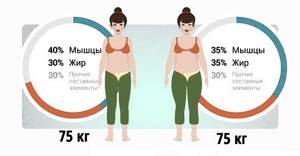
Fat percentage can be calculated using an online calculator
The main principles of the weight loss process should be:
- reducing calorie intake with the introduction of a sufficient amount of protein into the diet, which is a building material for muscle tissue;
- the calorie deficit should be moderate so that fat is lost, but muscle mass is maintained, that is, 20-25%;
- when training 4-6 hours a week, you need to consume 2.4 g of protein, 2 g of carbohydrates and 0.4 g of fat per kilogram of weight;
- preferences in the gym should be given to basic exercises, as well as jogging and weight training;
- Knowledge about the main types of body structure will help you plan the training process correctly.
Important! For those new to the gym, losing fat and gaining muscle is fairly easy and quick, provided you eat right and exercise regularly.
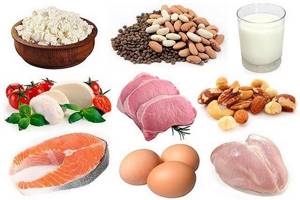
To successfully lose weight you need to eat enough protein foods.
Lack of muscle mass
Congenital muscle deficiency is diagnosed as “muscular dystrophy” . It may occur as a result of innate metabolic characteristics (for example, when the metabolic rate is too fast, a person may lose muscle tissue).
The frequency of occurrence is high in adolescents who do not exercise and do not eat enough. At this time, the endocrine and reproductive systems are formed, which expends the maximum amount of energy.
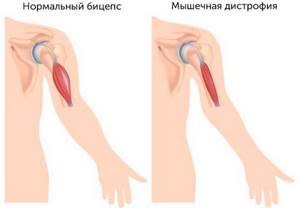
This is a disease in which a person’s body weight is reduced to critical levels and can pose a threat to life and development. The patient finds it difficult to perform not only exercises, but also normal movements such as walking or getting up from the floor.
Sarcopenia is a lack of muscle mass due mainly to improper diet and exercise. Despite the thriving “body cult,” sarcopenia is common among healthy lifestyle enthusiasts.
Muscle mass (the norm in women is slightly lower than in men) performs regulatory functions. Why do metabolic diseases develop due to lack of muscle mass?
Symptoms of a lack of muscle mass are, first of all, muscle weakness and a tendency to degeneration, decreased intelligence, vision, and hormonal imbalances. Accurate diagnosis of the disease is made using bioimpedansometry (body composition analysis), questionnaires and measurement of hand girth.
On average, less than 40% (in men) and 34% (in women) of the muscles of the total body weight is recognized as a deficiency.

To prevent lack of muscle mass, it is recommended:
- Consume enough protein.
- Maintain a balance or surplus in caloric intake.
- Add a calcium source.
- For enzymatic dysfunction that prevents the digestion of proteins from food, add green vegetables and herbs to the diet.
- Increase the content of Omega-3 fatty acids. Sources can be fish oil, flaxseed oil or dietary supplements.

